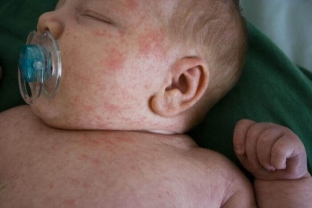What kind of worries do moms face. One of the unpleasant problems with the onset of the spring-summer period is prickly heat in children. Even with proper hygiene of the baby, you can meet such a manifestation. But do not be too nervous, as it can be effectively dealt with. The main thing in this situation is to correctly establish the diagnosis and take the necessary measures to eliminate it. Prevention of symptoms of prickly heat is also of no small importance. How to distinguish prickly heat from other diseases with similar manifestations?
What is prickly heat, diagnostics
Signs of prickly heat can be redness and irritation on the skin of the child, especially in those places that gather in nice folds. Its features are defined by:
- A rash that is red or pinkish, and sometimes small blisters that burst over time. Often in places where baby's skin comes into contact with clothing;
- The appearance of itching, the baby begins to itch and worry;
- Increased secretion of sweat glands;
- The appearance of "weeping skin syndrome".
Prickly heat occurs because the ambient temperature rises, and the baby's skin is too delicate and does not fully cope with the protection function. If the baby is too warmly dressed for high air temperatures, then when wet skin and clothes come into contact, an environment is created in which pathogenic bacteria multiply.
Perhaps, you lubricate the baby with protective creams too abundantly, and the skin stops breathing properly, and bacterial flora develops under the film that they create.
Also, manifestations of prickly heat are possible after a rise in body temperature in various infectious diseases.
Incorrect or untimely hygienic care can also lead to similar consequences. Do not confuse signs of miliaria with other diseases, such as dermatitis or allergic reactions. Be especially careful if the rash is accompanied by fever or other warning signs. It's also not worth diagnosing yourself. If you are faced with such a problem, consult a pediatrician, insists estet-portal.com. Only an experienced specialist can determine a particular disease.
What types of prickly heat do children have?
Even with such a simple disease as prickly heat, it would seem that not everything is simple. There are several types of prickly heat:
- Crystalline, white (pearl) bubbles appear, the skin does not become inflamed. Blisters may coalesce and flake, disappear in 2-3 days;
- Red, on inflamed red skin, bubbles appear that do not merge, are localized near the sweat glands, cause concern to the child, are accompanied by itching, last 2 weeks;
- Deep, characterized by the appearance of skin-colored bubbles that form on the upper layer of the epidermis, quickly disappear.
The localization of manifestations of prickly heat is usually noted on the face, cervical region, back or groin.

Treatment and prevention of prickly heat in children
Prickly heat can be treated at home, it responds well to treatment. If this situation happened, then:
- Take a bath with a decoction of string, chamomile, yarrow. They give a good anti-inflammatory effect. A thirty-minute bath will perfectly relieve redness and irritation of the skin, during the day you can simply wipe the affected areas with a soft cloth dipped in a decoction of herbs.
- You can use baby powder, they remove excess moisture from the skin and relieve irritation. It is better to use powders with the addition of panthenol.
- It is also possible to use ointments and creams based on the same panthenol or zinc.
To avoid recurrence of symptoms of prickly heat, take preventive measures:
- For babies – taking air and sunbathing is mandatory so that the skin breathes.
- Do not try to wrap up the baby once again. It is generally accepted that a child should be dressed in the same way as himself, but minus one layer of clothing. They have completely different thermoregulation.
- Only use clothes made from hygienic and natural materials for babies.
- Change diapers and diapers in time, do not force the baby to walk in wet clothes.
- Be sure to wash your baby after he has a bowel movement.
- Take a bath every night.
Stick to our recommendations and raise healthy babies.






Add a comment